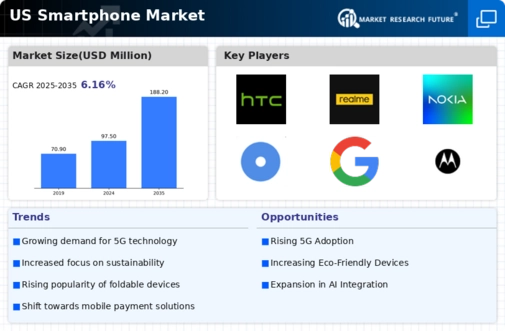Expansion of 5G Infrastructure
The expansion of 5G infrastructure across the US is a pivotal driver for the smartphone market. As telecommunications companies invest heavily in 5G networks, the availability of high-speed internet is becoming more widespread. This development encourages consumers to upgrade to 5G-compatible smartphones to take full advantage of enhanced connectivity and faster download speeds. Current estimates suggest that by the end of 2025, approximately 80% of smartphone users in urban areas will have access to 5G networks. This trend is likely to stimulate demand for new devices, as consumers seek to leverage the benefits of 5G technology, thereby propelling growth within the smartphone market.
Shift Towards Subscription-Based Models
The smartphone market is witnessing a notable shift towards subscription-based models, which may reshape consumer purchasing behavior. Companies are increasingly offering devices through leasing or subscription services, allowing consumers to pay a monthly fee instead of a lump sum. This model appears to lower the barrier to entry for acquiring high-end smartphones, potentially increasing market penetration. As of 2025, it is estimated that around 30% of smartphone sales in the US could be attributed to subscription services. This trend not only benefits consumers by providing flexibility but also enables manufacturers to maintain a steady revenue stream, thereby influencing the overall dynamics of the smartphone market.
Increased Demand for Mobile Applications
The smartphone market is significantly impacted by the growing demand for mobile applications across various sectors. As more consumers rely on smartphones for daily tasks, the need for diverse and functional applications has surged. Reports indicate that the US mobile app market is projected to reach approximately $200 billion by 2026, reflecting a robust growth trajectory. This demand encourages smartphone manufacturers to enhance their devices' capabilities, ensuring compatibility with the latest applications. Consequently, the smartphone market benefits from this trend, as consumers are more likely to upgrade their devices to access advanced applications, thereby stimulating sales and fostering innovation within the industry.
Technological Advancements in Mobile Hardware
The smartphone market is currently experiencing rapid technological advancements in mobile hardware, which significantly influences consumer purchasing decisions. Innovations such as improved processors, enhanced camera capabilities, and longer battery life are becoming standard features. For instance, the introduction of 5G technology has led to a surge in demand, with estimates suggesting that 5G-enabled devices could account for over 50% of total smartphone sales in the US by 2026. This trend indicates that consumers are increasingly seeking devices that offer superior performance and connectivity, thereby driving growth in the smartphone market. As manufacturers continue to invest in research and development, the competition intensifies, leading to a broader range of options for consumers and potentially higher sales volumes.
Growing Focus on Privacy and Security Features
The smartphone market is increasingly shaped by consumer concerns regarding privacy and security. As data breaches and privacy violations become more prevalent, consumers are prioritizing devices that offer robust security features. Manufacturers are responding by integrating advanced security measures, such as biometric authentication and end-to-end encryption, into their smartphones. This focus on security is likely to drive consumer preference towards brands that emphasize these features, potentially influencing purchasing decisions. In 2025, it is projected that over 60% of consumers in the US will consider security features as a critical factor when selecting a smartphone, thereby impacting the competitive landscape of the smartphone market.
















Leave a Comment